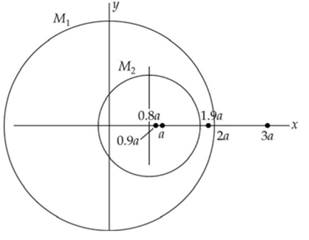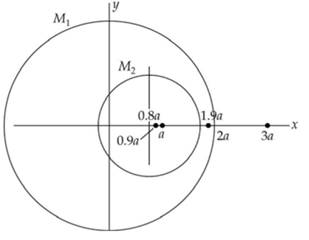
Concept explainers
(a)
To Calculate:The magnitude of gravitational force due to
(a)
Answer to Problem 74P
Explanation of Solution
Given data:
Radius of
Center has shifted,
Formula Used:
Gravitational field:
Where, G is the gravitational constant, m is the mass and r is the distance of the point where field is calculated.
The gravitational force is a force of attraction between any two bodies having mass and separated by a distance d . Mathematically, the gravitational force can be represented by:
Where, G is the gravitational constant, m and M are the masses and r is the distance between them.
Calculation:

The magnitude of force due to
Again, due to
Force,
Hence, net force
At
Conclusion:
Thus, the magnitude of gravitational force due to
(b)
The magnitude of gravitational force due to
(b)
Answer to Problem 74P
Explanation of Solution
Given data:
Radius of
Center has shifted,
Formula Used:
Gravitational field:
Where, G is the gravitational constant, m is the mass and r is the distance of the point where field is calculated.
The gravitational force is a force of attraction between any two bodies having mass and separated by a distance d . Mathematically, the gravitational force can be represented by:
Where, G is the gravitational constant, m and M are the masses and r is the distance between them.
Calculation:

The value of
Hence,
The value of
Hence, net force
Conclusion:
Thus, the magnitude of gravitational force due to
(c)
The magnitude of gravitational force due to
(c)
Answer to Problem 74P
Explanation of Solution
Given data:
Radius of
Center has shifted,
Formula Used:
Gravitational field:
Where, G is the gravitational constant, m is the mass and r is the distance of the point where field is calculated.
The gravitational force is a force of attraction between any two bodies having mass and separated by a distance d . Mathematically, the gravitational force can be represented by:
Where, G is the gravitational constant, m and M are the masses and r is the distance between them.
Calculation:

The value of
Again, the value of
So,
Hence, net force
Conclusion:
Thus, the magnitude of gravitational force due to
Want to see more full solutions like this?
Chapter 11 Solutions
Physics for Scientists and Engineers
- Suppose the gravitational acceleration at the surface of a certain moon A of Jupiter is 2 m/s2. Moon B has twice the mass and twice the radius of moon A. What is the gravitational acceleration at its surface? Neglect the gravitational acceleration due to Jupiter, (a) 8 m/s2 (b) 4 m/s2 (c) 2 m/s2 (d) 1 m/s2 (e) 0.5 m/s2arrow_forwardThe gravitational force exerted on an astronaut on the Earths surface is 650 N directed downward. When she is in the space station in orbit around the Earth, is the gravitational force on her (a) larger, (b) exactly the same, (c) smaller, (d) nearly but not exactly zero, or (e) exactly zero?arrow_forwardWhat is the orbital radius of an Earth satellite having a period of 1.00 h? (b) What is unreasonable about this result?arrow_forward
- (a) Find the magnitude of the gravitational force between a planet with mass 7.50 1024 kg and its moon, with mass 2.70 1022 kg, if the average distance between their centers is 2.80 108 m. (b) What is the acceleration of the moon towards the planet? (c) What is the acceleration of the planet towards the moon?arrow_forwardLet gM represent the difference in the gravitational fields produced by the Moon at the points on the Earths surface nearest to and farthest from the Moon. Find the fraction gM/g, where g is the Earths gravitational field. (This difference is responsible for the occurrence of the lunar tides on the Earth.)arrow_forwardTwo black holes (the remains of exploded stars), separated by a distance of 10.0 AU (1 AU = 1.50 1011 m), attract one another with a gravitational force of 8.90 1025 N. The combined mass of the two black holes is 4.00 1030 kg. What is the mass of each black hole?arrow_forward
- Compute directly the gravitational force on a unit mass at a point exterior to a homogeneous sphere of matter.arrow_forwardThree identical very dense masses of 7100 kg each are placed on the x axis. One mass is at x1 = -110 cm , one is at the origin, and one is at x2 = 320 cm. What is the magnitude of the net gravitational force Fgrav on the mass at the origin due to the other two masses? Take the gravitational constant to be G = 6.67×10−11 N⋅m2/kg2 . What is the direction of the net gravitational force on the mass at the origin due to the other two masses?arrow_forwardWhat is the ratio of the sun's gravitational pull on Mercury to the sunfs gravitational pul on the earth? The radius of the orbit of Mercury is RM 5.79 x 10 m and its mass is my - 1.50 × 10 m and its mass is mp = 5,97 x 10 kg 5.97 x 1024 kg =D3.30x10 kg. The radius of the orbit of Earth is Rp 阳 AX中 FM FEarrow_forward
- The diagram below shows three masses at the corners of a square of sides d = 1.10 m. Here, m, = m, = m and m, = 3.10m where m = 9.00 kg. m, m3 m1 (a) What is the magnitude of the gravitational field at the center of the square due to these three masses? 1.39e-9 What is the field at the center due to the two equal masses? Did you consider the symmetry of the situation? m/s2 (b) Suppose the two masses m, and m, are not equal. What value of m, will produce a gravitational field at the center of the square directed vertically down? kgarrow_forwardOne dimension. In the figure, two point particles are fixed on an x axis separated by distance d. Particle A has mass ma and particle B has mass 9.00 mA. A third particle C, of mass 90.0 ma, is to be placed on the x axis and near particles A and B. In terms of distance d, at what x coordinate should C be placed so that the net gravitational force on particle A from particles B and C is zero? B. Number Units *d Use correct number of significant digits; the tolerance is +/-2%arrow_forwardWhat must the separation be between a 5.7 kg particle and a 3.0 kg particle for their gravitational attraction to have a magnitude of 3.137×10-11 N? .arrow_forward
 Physics for Scientists and Engineers: Foundations...PhysicsISBN:9781133939146Author:Katz, Debora M.Publisher:Cengage Learning
Physics for Scientists and Engineers: Foundations...PhysicsISBN:9781133939146Author:Katz, Debora M.Publisher:Cengage Learning Principles of Physics: A Calculus-Based TextPhysicsISBN:9781133104261Author:Raymond A. Serway, John W. JewettPublisher:Cengage Learning
Principles of Physics: A Calculus-Based TextPhysicsISBN:9781133104261Author:Raymond A. Serway, John W. JewettPublisher:Cengage Learning Glencoe Physics: Principles and Problems, Student...PhysicsISBN:9780078807213Author:Paul W. ZitzewitzPublisher:Glencoe/McGraw-Hill
Glencoe Physics: Principles and Problems, Student...PhysicsISBN:9780078807213Author:Paul W. ZitzewitzPublisher:Glencoe/McGraw-Hill Classical Dynamics of Particles and SystemsPhysicsISBN:9780534408961Author:Stephen T. Thornton, Jerry B. MarionPublisher:Cengage Learning
Classical Dynamics of Particles and SystemsPhysicsISBN:9780534408961Author:Stephen T. Thornton, Jerry B. MarionPublisher:Cengage Learning University Physics Volume 1PhysicsISBN:9781938168277Author:William Moebs, Samuel J. Ling, Jeff SannyPublisher:OpenStax - Rice University
University Physics Volume 1PhysicsISBN:9781938168277Author:William Moebs, Samuel J. Ling, Jeff SannyPublisher:OpenStax - Rice University College PhysicsPhysicsISBN:9781305952300Author:Raymond A. Serway, Chris VuillePublisher:Cengage Learning
College PhysicsPhysicsISBN:9781305952300Author:Raymond A. Serway, Chris VuillePublisher:Cengage Learning





